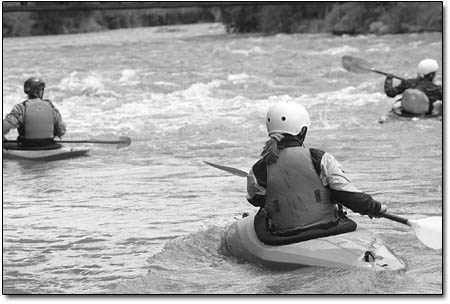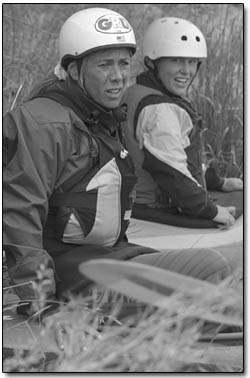| Staying
afloat in paddlesports takes gumption, guts and grace written by Missy Votel
Sidebar: Animas River Days
beckons to local boaters
 |
| Local female paddlers
make their way down the Animas from the 9th Street
put-in Sunday./Photo by Todd Newcomer |
They’re mothers, girlfriends, wives; Realtors,
teachers, waitresses. But they all have one thing in common:
an addiction they can’t seem to shake. They’re
whitewater junkies.
“It was just so exciting and scary, I couldn’t
stop,” said local paddler Michelle Brown, a teacher
off the water. “I started doing it every day, sometimes
twice a day.”
Lynn Brown (no relation), a Durango mother of two who
does triathlons in her spare time, also admits to a once-a-day
habit.
“I go every day,” said Lynn, who has been
boating for close to two decades. “I boat for the
excitement. You just don’t get that with biking
or Nordic skiing, and that’s what makes boating
so great.”
Julie Barber, a Durango massage therapist who started
boating this year, admits her addiction came about as
a result of peer pressure.
“I started because I knew I wouldn’t have
any friends in the spring if I didn’t,” she
said.
All three are among a growing group of local women sharing
the eddies that have traditionally been male-only domain.
“I definitely think there are more women on the
river today,” said Nancy Wiley, the middle sister
in Durango’s powerhouse kayaking trio, which also
includes sisters Amy and Janet.
And Wiley says she welcomes the company.
“I’m always psyched to see more women on
the river, out doing tricks in the holes,” said
Wiley, who was surfing Santa Rita in her Hollowform before
she could drive. “It’s exciting for me to
see.”
Of course Wiley, who started boating in 1975 at the tender
age of 13, admits there was only room for improvement
in the male-female boating ratio.
“When I started there were only about four kayakers
in town,” she said, rattling off a short list of
men, one of which was her father, the late Milt Wiley,
arguably the father of Durango boating. “I started
because my dad wanted me to learn so he’d have a
buddy to go with.”
And while a lucky draw in the gene pool, abs of steel
and biceps like lead cans (which, incidentally, all these
women possess) can’t hurt one’s paddling quest,
all agree these things are by no means a necessity. In
fact, Wiley insists there’s a lot more to be said
for finesse vs. brute force.
 |
Lynn Brown, left, and Julie Barber
make final preparations prior to launching for a Sunday
afternoon paddle. /Photo by
Todd Newcomer |
“There’s no way a man or woman can overpower
the river,” she said. “While sometimes men
can get by on their strength, women learn how to use water
to their advantage.”
In fact, next to her father, Wiley cites her biggest
influence as Ellen Perry, a pioneering boater from Carbondale.
“Ellen Perry was my first female inspiration that
women can do it, and do it gracefully,” she said.
Of course, the only way to do this is to start from the
bottom up – quite literally.
“My advice is to start at the pool and boat the
river at every level or it’ll get away from you...and
get a lot of ibuprofen,” said Barber, who admits
to hitting her combat roll “most of the time.”
Which, of course, brings up the all-important issue of
the roll – often the bane of any boater’s
existence.
“The first time I flipped I was out of my boat
before my head hit the water,” said Wiley, speaking
to the fear that plagues anyone with enough sense to know
being upside-down underwater can have detrimental effects.
Yet, a solid roll can spell the difference between success
and failure – not only from a safety standpoint
but a self-confidence one as well.
“Get your roll down and take your time,”
said Michelle Brown, who’s been playboating for
about eight years. “Playboating’s not scary
– if you have a roll, you can do it.”
Lisa Wilk, another matriarch of the local boating scene
with more than 20 years under her belt, also stressed
the importance of the basics.
“If you really want to do it, you’ve got
to get out there and do the flat water, practice those
strokes and put the time in,” she said.
Self determination – as well as a little hard headedness
– also plays a role in keeping the novice boater’s
dream alive, she said.
“I can’t believe I stuck with it,”
said Wilk, whose first boat was a used, fiberglass Phoenix
Savage. “I had some terrible swims and yard sales,
but I really, really wanted to learn.”
Barber agrees that a tough mental attitude has helped
her progress in the sport as well.
“It’s one of those things where you know
you can do it, so you have to do it,” she said.
“There’s no reason you shouldn’t.”
Nevertheless, having a friend around to share in your
sorrow and triumphs, or just to fetch your boat when you
swim and laugh once she knows you’re OK, makes the
whole process a lot easier.
“Find a friend; find a buddy,” said Michelle
Brown.
And oftentimes – with all due respect to womens’
male boating/life partners – this comes in the form
of a fellow female boater.
“Although I have fun with the guys, it’s
such a different vibe with the girls,” said Joanne
Farley, a longtime paddler who gave up her kayak several
years ago in favor of an open canoe. “It’s
always more fun with your friends.”
Alli Gober, a waitress and local slalom racer who recently
began a foray into the world of rodeo boating, agrees
– although she admits it may get her into trouble
with her male counterparts.
“Boating with women is so great,” she said.
“Women don’t have that ‘I’m gonna
kill the river’ attitude.”
In fact, any attitude at all is best left on the shore,
the women agree. And a healthy sense of humility and humor
can’t hurt, either, especially when the laugh is
at your own expense. There isn’t a boater out there
who doesn’t have her own tale of woe and anxiety.
Farley, the canoeist, told of a story when she inadvertently
got stuck in a hole with a large crowd watching.
“People were cheering me on because they thought
I was trying to do tricks,” she said. “Eventually
I flipped and swam out of the hole and thought, ‘Well,
there goes my cover.’”
Another boater, Tina Reed, a Durango real estate agent,
holds what she thinks is the record number of swims in
one season in Smelter Rapid – a record she proudly
challenges anyone to beat.
“I swam Smelter 22 times my first summer,”
she said.
Reed isn’t the only one troubled by the crux move
on Durango’s town run. Even the most experienced
women spoke to the “cleansing” effect of the
rapid.
“Boating’s the best laxative,” said
Lynn Brown. “I still get nervous every time I run
Smelter. I just hit that right line and keep on going.”
Even Wiley has had her share of mishaps there, including
one a few weeks ago in her canoe.
“I ran Smelter and wasn’t prepared for those
waves right afterward,” she said. “I had stopped
paddling and was just sitting there, and before I knew
it, I had turned sideways and got tipped over.
“I was laughing that the river had gotten me 85
and it also made me realize that I need to practice swimming.”
As Barber so succinctly sized up the grounding effect
of the river: “Whenever you start to feel like hot
shit, go boat.”
Of course, all these tales of terror on the high rivers
may make any potential boater question whether the pain
and suffering, and bruised shins and bruised egos are
worth it. But these women agree that it all pays off –
in more ways than one.
“There’s always going to be a swim around
the next corner, there’s always going to be a better
boater than you, but if you stick with it, you always
get better,” said Wilk. “And I’ve never
stopped getting better.”
Gober, who was boating Class V in her second season of
boating, said even she has her off days.
“The other day, I was having the worst day, flipping
all over the place,” she said. “And then I
found this one wave and said, ‘Ok, I’m just
going to try to front surf it.’ And I ended up having
the longest surf. Every 30 seconds I said, ‘thank
you river, thank you river,’” she said.
And it’s those little, serendipitous experiences
– rather than the big drops and churning holes –
that keep her coming back for more.
“Every time you go out, I think it’s important
to appreciate the river and what a gorgeous place it is,”
she said.
|

